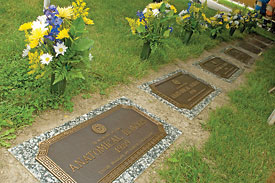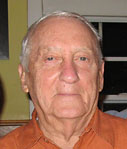It is only by going deep under the skin that medical students can truly grasp the intricacies of the human body — something that Casey White knows is vital to preparing physicians.

White, assistant dean for medical education, joined U-M’s medical students last week to honor those who have donated their bodies to the Medical School. But at this year’s service, White honored not only the 300 or so people whose bodies are used each year to further medical study and research.
She also honored her father.
“Shortly after my mother died and was cremated in 2002, my father gave me a letter he had recently written. The letter said that — when he passed — he wanted his body to be donated to the U-M Medical School,” White says.
“He was very proud of the work that we do educating future physicians, and he wanted to contribute to that in some meaningful way.”
Peter Anthony Kirchoff, White’s father, died unexpectedly in April. He was 89, just shy of his 90th birthday. This year, six of U-M’s beginning medical students will gain intimate knowledge of human anatomy using his body.
“I’m so proud of him, it’s a great gift,” White says. “He knew what I do at my job, and he wanted the medical students to have the remains.”
White addressed the 170 medical students in this year’s gross anatomy class in late August, telling them a bit about her father. That he loved a good joke and a cold Smithwick’s ale. That he served his country in World War II. That he loved his family, and moved to Ann Arbor in his retirement so he could watch his grandson grow up.
“We loved our father beyond words, and although we will hold our memories of him in our hearts forever, we now pass his body on to you,” White told the students.
“They kept clapping and clapping and clapping,” White says about the reaction from the students.

That’s the reason for the annual service, says Thomas Gest, director of the Anatomical Donations Program. They need to know this is not just a body — it was somebody’s mom, brother, child or friend, Gest says.
“All of our donors are thinking ‘How can I do one last thing?’ ” Gest says. “It’s unbelievable charity.”
The annual ceremony is student-led, and featured medical students who volunteered to play instruments and sing in a choir. Four current students and one Medical School graduate addressed those gathered — about 1,000 people — sharing their gratitude for the anatomical donations.
Sarah Arshad, a first-year medical student from New Jersey, says she will carry her anatomy experience with her throughout her career.
“I realize now there is no better way to learn about the intricacies of the human body,” Arshad says, explaining the invaluable knowledge gained from studying her cadaver. “All this I learned from a man who technically is not alive. But he has taught me more about life than someone still breathing.
“To the man who donated his body to my small group, I say your life did not end at the time written on your death certificate.”
The Anatomical Donations Program receives approximately 300 whole body donations each year. The donors are with the school for about a year and then the ashes are either returned to the family or they are buried at Washtenong Park.
Bequests are greatly appreciated. For more information about the program, call 734-764-4359 or go to www.med.umich.edu/anatomy/donors/.

